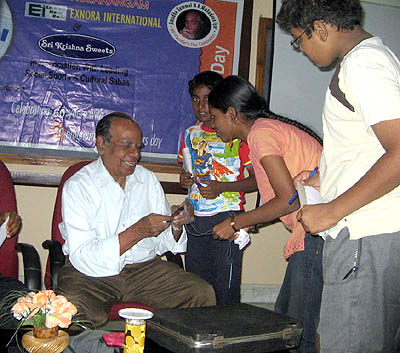Can you nail a nail on a piece of wood using a raw banana as a hammer?
Or can you break a rubber ball by dropping it on the ground? These were some of the things demonstrated at a program titled ‘Fun with Science’. It was conducted on Sep. 20 at the Birla Planetarium.
 The first part of the program was conducted by Prof. P. Devadas. He is also the President of Tamil Nadu Astronomy Club, a member of Optical Society of India, a member of the British Astronomical Association and he is a telescope making engineer and an amateur scientist who has made more than 4000 telescopes for Indian schools and colleges.
The first part of the program was conducted by Prof. P. Devadas. He is also the President of Tamil Nadu Astronomy Club, a member of Optical Society of India, a member of the British Astronomical Association and he is a telescope making engineer and an amateur scientist who has made more than 4000 telescopes for Indian schools and colleges.
He explained basics of about astronomy with the help of a PowerPoint presentation. He spoke about saberial and sainadic revolution of the moon, the celestial co-ordinate system which is used for the sky instead of longitude and latitude and the vernal and autumnal equinoxes. He said that the sky is divided into 24 divisions and 360° in which one hour is equal to 15°.
“The Rig Vedic people knew this and used this to create the lunar calendar. The Babylonians also used this to make their zodiac constellation calendar for which the sky is divided into 12 divisions.” Said Prof. Devasas.
He also shared a few facts like the distance between the earth and the sun is 93 million miles. Then he explained about the bodies of the solar system starting with the sun.
He also explained about sun spots and the aurora borealis which are bright colours seen in the sky in Antarctica or in Australia which is created when sun rays’ magnetic particles and the earth’s magnetic particles join together.
The moon he said is of diameter 2163 miles and that the craters formed on the moon are due to the impact of the falling of asteroids.
He also told that according to his new theory, which he presented to the astronomical societies in UK and got appreciation, these were basins of lava years ago around which there are many layers of lava. Then he explained about Mercury, Venus whose atmospheric pressure is 98 % more than that of the earth, Mars which has Olympus- the highest volcano in the solar system. The Himalayas on earth is only 10 km high. But this volcano is 28 km high. He also told about Jupiter which is 11 times bigger than earth, got 63 satellites and one of the 4 bigger satellites, the Io, and has 81 active volcanoes.
It was the time for tea and snacks was provided by the sponsor, Sri Krishna Sweets.
The second part had interesting experiments.
The syringe experiment showed that air can be compressed but liquids cannot be.
In the next experiment a boiled egg went into a beaker, whose mouth is too small for it, all by itself! A small piece of burning camphor was put into the beaker and a boiled egg was placed on top of its mouth. As the fire absorbed all the air between the egg and the beaker’s bottom, a vacuum was created there. The outer air pushed the egg from the top and the egg went inside with a loud pop. This showed that air is around us and air exerts pressure.
After that a generous amount of liquid nitrogen was poured into a thermocol container which was used for two or three experiments. A rubber ball was dipped into it and it was taken out after a few seconds. When it was dropped on the ground it shattered into many pieces as if it was glass, instead of bouncing!

